Yakisugi
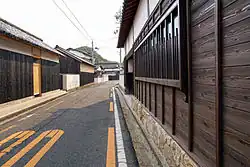
Yakisugi (Japanese: 焼 杉, lit. 'burnt Japanese cedar '[1]) is a traditional Japanese method of wood preservation.[2][3][1] It is also referred to as shō sugi ban (焼杉板), a term which uses the same kanji characters, but an alternative pronunciation. The ban character means "plank". In the West, it is known as burnt timber cladding.
Process and properties
By partially charring the surface of the wood without combusting the entire piece, the surface becomes water-resistant through carbonization, and its hygroscopy is reduced due to chemical cellular changes during the carbonization process, which results in increased durability.[4][5] It additionally protects the wood against insects, fungi and mold, as well as making the wood more fire-resistant.[6] This traditional technique has several similarities with the modern thermal wood modification[7] methods used in Europe and elsewhere.
However, some studies have shown that surface charring alone does not improve its durability or its resistance to fire or water.[8]
Contemporary applications
Contemporary architect Terunobu Fujimori employs yakisugi in his designs.[9][10] Japanese architect Kengo Kuma also incorporates this charred wood material in his architectural works.[11]
Gallery
In detail
-
 Surface detail showing charred texture
Surface detail showing charred texture -
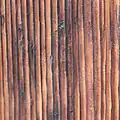 Close-up of yakisugi surface pattern
Close-up of yakisugi surface pattern -
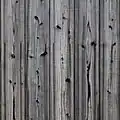 Yakisugi texture detail from Kyoto
Yakisugi texture detail from Kyoto -
 Charred wood surface showing carbonization
Charred wood surface showing carbonization
In use
-
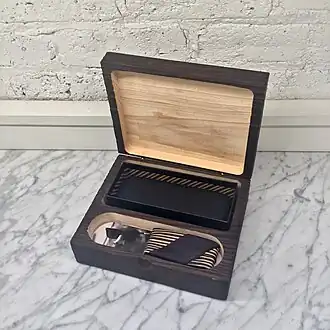 Yakisugi treated wood used in a box for sunglasses
Yakisugi treated wood used in a box for sunglasses -
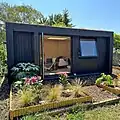 Western garden room with yakisugi cladding
Western garden room with yakisugi cladding
References
- ^ a b MacDonald, Deanna (9 February 2016). Eco Living Japan: Sustainable Ideas for Living Green. Tuttle Publishing. ISBN 978-1-4629-1845-4.
- ^ Ebner, David Hans; Barbu, Marius-Catalin; Klaushofer, Josef; Čermák, Petr (2021). "Surface Modification of Spruce and Fir Sawn-Timber by Charring in the Traditional Japanese Method—Yakisugi". Polymers. 13 (10): 1662. doi:10.3390/polym13101662. PMC 8160771. PMID 34065260.
- ^ Fortini, Amanda (19 September 2017). "The Latest Design Trend: Black and Burned Wood". The New York Times.
- ^ "Use This Incredible Technique to Waterproof Wood Furniture". Architectural Digest. 3 November 2017.
- ^ Mehta, Geeta; MacDonald, Deanna (9 July 2012). New Japan Architecture: Recent Works by the World's Leading Architects. Tuttle Publishing. ISBN 978-1-4629-0850-9.
- ^ Steele, James (16 March 2017). Contemporary Japanese Architecture: Tracing the Next Generation. Routledge. ISBN 978-1-317-37728-3.
- ^ "Thermal Wood Modification". Springer Handbook of Wood Science and Technology. Cham: Springer International Publishing. 2023. pp. 899–906. doi:10.1007/978-3-030-81315-4. ISBN 978-3-030-81314-7. ISSN 2522-8692. S2CID 257902863.
- ^ Hasburgh, Laura E.; Zelinka, Samuel L.; Bishell, Amy B.; Kirker, Grant T. (16 September 2021). "Durability and Fire Performance of Charred Wood Siding (Shou Sugi Ban)". Forests. 12 (9): 1262. doi:10.3390/f12091262.
- ^ Wilton, Megan (11 March 2009). "Yakisugi House by Terunobu Fujimori". Dezeen.
- ^ Sumner, Yuki (28 August 2009). "Interiors: A Japanese Charred-Timber House Inspired by a Cave Dwelling". The Daily Telegraph.
- ^ Kuma, Kengo (3 June 2022). "Yakisugi Forest". Kuma Kengo and Associates. Retrieved 27 November 2024.
External links
 Media related to Yakisugi at Wikimedia Commons
Media related to Yakisugi at Wikimedia Commons